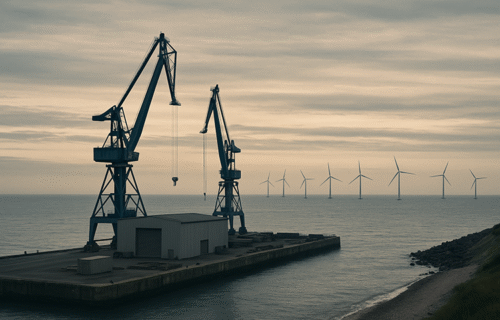Europe’s offshore-wind industry, once the continent’s clean-energy success story, is entering a period of visible strain. After years of rapid growth and record investment, the sector is now slowing under the weight of higher costs, complex permitting, and uncertain policy signals. The warning signs are multiplying: auctions are failing to attract bidders, project timelines are slipping, and manufacturers are starting to pause expansion plans. The clearest signal came this month when Denmark’s Vestas Wind Systems halted construction of its planned turbine-blade factory in Poland, citing weaker-than-expected demand for offshore wind across Europe.
For more than a decade, Europe led the world in offshore-wind technology, setting ambitious targets and building a sophisticated network of ports, shipyards, and suppliers. That momentum has faltered in recent months. Rising material and transport costs, coupled with sharply higher interest rates, have eroded project profitability. Developers that once competed aggressively for auctioned sites are now holding back, wary of financial losses. At the same time, grid connection delays and cumbersome approval processes continue to stretch construction timelines. These factors have combined to weaken near-term demand for new turbines and the manufacturing facilities that produce them.
Germany’s experience has been particularly revealing. In the country’s most recent auction for new offshore capacity, there were no bids at all — a stark contrast to the oversubscribed rounds seen only a few years ago. Industry observers said that project economics have deteriorated so significantly that some sites are no longer viable under current rules. While smaller tenders have gone ahead, the broader slowdown is forcing policymakers in Berlin to reconsider how to make auctions attractive again.
The United Kingdom offers a partial counterpoint. After a failed tender in 2023 that yielded no offshore contracts, the following year saw renewed momentum with six gigawatts of new capacity awarded, including the country’s first large-scale floating wind farms. However, even in Britain, developers caution that inflation and grid delays could postpone completion dates, limiting the immediate flow of new orders for manufacturers.
The Netherlands remains a rare bright spot. The country has managed to keep its buildout largely on track thanks to clear permitting procedures, close coordination between government and grid operator, and pre-developed project sites. Yet Dutch officials have also warned that sustained cost inflation could make future rounds more difficult, particularly if financing conditions remain tight.
Poland’s position is more precarious. The country has long sought to position itself as a manufacturing base for offshore-wind equipment in the Baltic region. Vestas’s decision to suspend its new factory near Szczecin — a project expected to employ over a thousand people — puts that vision in doubt. The facility was designed to supply blades for next-generation offshore turbines, but with developers across Europe scaling back timelines, the market outlook has become too uncertain to justify immediate construction. Political turbulence surrounding renewable-energy reforms in Warsaw has further unsettled investor confidence.
Across Europe, the pattern is the same: lofty targets remain in place, but delivery is lagging behind. The European Union’s goal of 129 gigawatts of installed offshore capacity by 2030 is now considered out of reach, with analysts suggesting that only about 80 to 85 gigawatts may realistically be achieved on current trajectories. This gap between ambition and execution is forcing turbine manufacturers to rethink production strategies and concentrate resources in regions with more reliable demand growth.
Despite the near-term setbacks, the offshore-wind sector remains critical to Europe’s long-term energy transition. Industry leaders argue that with faster permitting, better auction design, and improved grid infrastructure, the market could recover quickly. But without clear policy direction and stable investment frameworks, manufacturers may continue redirecting resources toward more dynamic markets in Asia and North America.
For now, Vestas’s decision to pause its Polish project stands as a symbol of the industry’s shifting balance. Once the heartbeat of Europe’s green transition, offshore wind is now caught between ambition and economic reality — a reminder that even the most advanced markets can lose momentum when policy certainty fades and costs rise faster than confidence.
